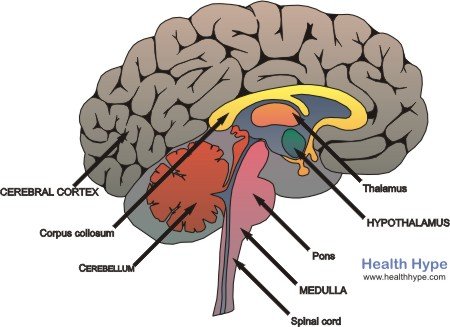Pituitary Gland Anatomy, Location, Hormones and Pictures
What is the Pituitary Gland?
The pituitary gland is considered as the master gland of the body because its hormones control other endocrine glands, which in turn influence various and diverse activities in the body. It is largely influenced by the hypothalamus, which is the control center that processes the incoming signals from various parts of the body and triggers the appropriate actions to maintain a state of balance (homeostasis). The hypothalamus sends hormonal signals to the pituitary gland to either stimulate or inhibit the production and secretion of certain hormones.
Pituitary Hormones
The pituitary gland can be divided according to its two compartments :
- Anterior lobe (adenohypophysis)
- Posterior lobe (neurohypophysis)
The anterior lobe which constitutes about 80% of the gland also produces and secretes most of the pituitary hormones. There are five types of cells responsible for hormone production in the anterior pituitary.
- Somatotrophs produce growth hormone (GH).
- Corticotrophs produce adrenocorticotropic hormone (ACTH), pro-opiomelanocortin (POMC), melanocyte-stimulating hormone (MSH), endorphins, and lipotropin.
- Gonadotrophs produce follicle-stimulating hormone (FSH) and luteinizing hormone (LH).
- Lactotrophs (mammotrophs) produce prolactin.
- Thyrotrophs produce thyroid-stimulating hormone (TSH).
Oxytocin and ADH (antidiuretic hormone/vasopressin) are the only two hormones that are released from the posterior pituitary gland. Both these hormones are produced in the hypothalamus but transported to and stored in the posterior pituitary.
Function of the Pituitary Gland Hormones
The pituitary gland itself responds to the hypothalamus to secrete hormones that will maintain homeostasis. Therefore the most basic function of the pituitary gland is to control other endocrine glands.
These pituitary hormones, either indirectly by acting on specific glands or directly on target tissues, can have the following effects :
- Growth and developments of cells and tissues – growth hormone
- Metabolic rate and heat production – thyroid-stimulating hormone
- Breast milk production and ejection – prolactin and oxytocin
- Water and electrolyte balance – vasopressin and adrenocorticotropin hormone (ACTH)
- Sexual functioning and reproduction – follicle-stimulating hormone (FSH) and luteinizing hormone (LH)
- Skin and hair pigmentation – melanocyte-stimulating hormone
- Regulates immune and inflammatory responses – adrenocorticotropin hormone (ACTH)
- Pain tolerance and mood – endorphins
- Body fat accumulation – lipotropin
Size of the Pituitary Gland
The pituitary gland is a small round organ that is about 1 centimeter in diameter and occupies a small groove in the base of the skull known as the sella turnica. Weighing in at between 0.5 to 1 gram, this small pea-sized gland is able to influence every other endocrine gland in the body and therefore known as the “master gland”.
The pituitary gland is controlled to a large extent by the hypothalamus (illustrated in the picture below) which lies above and slightly behind the gland. These two structures are connected by the pituitary stalk (also known as the hypophysial or infundibular stalk). The hypothalamus is able to send stimulatory or inhibitory hormones to the pituitary gland thereby regulating its action on other endocrine glands and the body as a whole.
Around the Pituitary Gland
Other structures around the pituitary gland include the :
- optic chiasm – above
- sphenoid sinuses – below
- cavernous sinuses (containing cranial nerve 3, 4, 6 and the internal carotid artery) – lateral (on either side)
These close relations to the pituitary gland are an important consideration if there are any pituitary problems related to space-occupying lesions – gland hyperplasia, tumors, hemorrhage or abscess. The pressure on the surrounding areas will elicit a host of signs or symptoms although the primary pituitary lesion may have gone unnoticed. The most prone of these areas is the optic chiasm. One of these complications is known as bitemporal hemianopsia, where the temporal visual field is impaired, as a result of compression on the structures of the optic chiasm.
Location of the Pituitary Gland
The pituitary gland’s location to the different parts of the central nervous system is illustrated in the picture below.
Anterior and Posterior Pituitary
The pituitary gland can be divided into two lobes – the anterior pituitary (adenohypohysis), which accounts for most of the pituitary gland, and the smaller posterior pituitary (neurohypophysis).

The anterior pituitary produces and secretes most of the pituitary hormones from five different types of cells within the anterior lobe. The cell types and hormones produced are discussed further under pituitary hormones. Blood vessels from the hypothalamus pass through the pituitary stalk to the anterior lobe where hypothalamic hormones can stimulate or inhibit the activities of the anterior pituitary.
The posterior pituitary is actually an extension of the hypothalamus and only secretes two hormones.The axons of the nerve cells originating in the hypothalamus end in the posterior lobe where it can secrete oxytocin or vasopressin. The continuation of the hypothalamic nerves into the posterior pituitary also makes up the pituitary stalk.
Between the anterior and posterior lobes lies a zone known as the pars intermedia. It has no function and is almost absent in humans although quite prominent in other animals.





